Diane Larlus
Layered Motion Fusion: Lifting Motion Segmentation to 3D in Egocentric Videos
Jun 05, 2025Abstract:Computer vision is largely based on 2D techniques, with 3D vision still relegated to a relatively narrow subset of applications. However, by building on recent advances in 3D models such as neural radiance fields, some authors have shown that 3D techniques can at last improve outputs extracted from independent 2D views, by fusing them into 3D and denoising them. This is particularly helpful in egocentric videos, where the camera motion is significant, but only under the assumption that the scene itself is static. In fact, as shown in the recent analysis conducted by EPIC Fields, 3D techniques are ineffective when it comes to studying dynamic phenomena, and, in particular, when segmenting moving objects. In this paper, we look into this issue in more detail. First, we propose to improve dynamic segmentation in 3D by fusing motion segmentation predictions from a 2D-based model into layered radiance fields (Layered Motion Fusion). However, the high complexity of long, dynamic videos makes it challenging to capture the underlying geometric structure, and, as a result, hinders the fusion of motion cues into the (incomplete) scene geometry. We address this issue through test-time refinement, which helps the model to focus on specific frames, thereby reducing the data complexity. This results in a synergy between motion fusion and the refinement, and in turn leads to segmentation predictions of the 3D model that surpass the 2D baseline by a large margin. This demonstrates that 3D techniques can enhance 2D analysis even for dynamic phenomena in a challenging and realistic setting.
Geo4D: Leveraging Video Generators for Geometric 4D Scene Reconstruction
Apr 10, 2025Abstract:We introduce Geo4D, a method to repurpose video diffusion models for monocular 3D reconstruction of dynamic scenes. By leveraging the strong dynamic prior captured by such video models, Geo4D can be trained using only synthetic data while generalizing well to real data in a zero-shot manner. Geo4D predicts several complementary geometric modalities, namely point, depth, and ray maps. It uses a new multi-modal alignment algorithm to align and fuse these modalities, as well as multiple sliding windows, at inference time, thus obtaining robust and accurate 4D reconstruction of long videos. Extensive experiments across multiple benchmarks show that Geo4D significantly surpasses state-of-the-art video depth estimation methods, including recent methods such as MonST3R, which are also designed to handle dynamic scenes.
DUNE: Distilling a Universal Encoder from Heterogeneous 2D and 3D Teachers
Mar 18, 2025Abstract:Recent multi-teacher distillation methods have unified the encoders of multiple foundation models into a single encoder, achieving competitive performance on core vision tasks like classification, segmentation, and depth estimation. This led us to ask: Could similar success be achieved when the pool of teachers also includes vision models specialized in diverse tasks across both 2D and 3D perception? In this paper, we define and investigate the problem of heterogeneous teacher distillation, or co-distillation, a challenging multi-teacher distillation scenario where teacher models vary significantly in both (a) their design objectives and (b) the data they were trained on. We explore data-sharing strategies and teacher-specific encoding, and introduce DUNE, a single encoder excelling in 2D vision, 3D understanding, and 3D human perception. Our model achieves performance comparable to that of its larger teachers, sometimes even outperforming them, on their respective tasks. Notably, DUNE surpasses MASt3R in Map-free Visual Relocalization with a much smaller encoder.
LUDVIG: Learning-free Uplifting of 2D Visual features to Gaussian Splatting scenes
Oct 18, 2024



Abstract:We address the task of uplifting visual features or semantic masks from 2D vision models to 3D scenes represented by Gaussian Splatting. Whereas common approaches rely on iterative optimization-based procedures, we show that a simple yet effective aggregation technique yields excellent results. Applied to semantic masks from Segment Anything (SAM), our uplifting approach leads to segmentation quality comparable to the state of the art. We then extend this method to generic DINOv2 features, integrating 3D scene geometry through graph diffusion, and achieve competitive segmentation results despite DINOv2 not being trained on millions of annotated masks like SAM.
UNIC: Universal Classification Models via Multi-teacher Distillation
Aug 09, 2024Abstract:Pretrained models have become a commodity and offer strong results on a broad range of tasks. In this work, we focus on classification and seek to learn a unique encoder able to take from several complementary pretrained models. We aim at even stronger generalization across a variety of classification tasks. We propose to learn such an encoder via multi-teacher distillation. We first thoroughly analyse standard distillation when driven by multiple strong teachers with complementary strengths. Guided by this analysis, we gradually propose improvements to the basic distillation setup. Among those, we enrich the architecture of the encoder with a ladder of expendable projectors, which increases the impact of intermediate features during distillation, and we introduce teacher dropping, a regularization mechanism that better balances the teachers' influence. Our final distillation strategy leads to student models of the same capacity as any of the teachers, while retaining or improving upon the performance of the best teacher for each task. Project page and code: https://europe.naverlabs.com/unic
What could go wrong? Discovering and describing failure modes in computer vision
Aug 08, 2024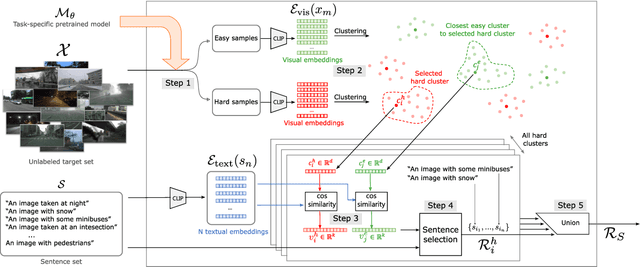
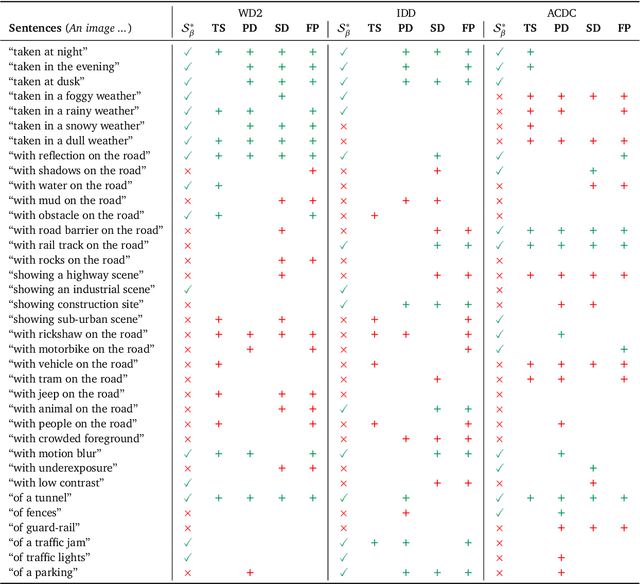
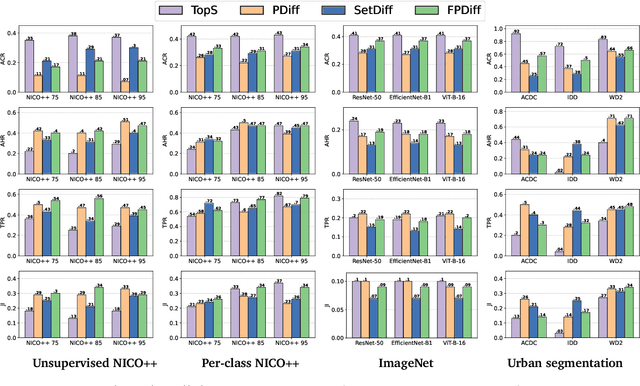

Abstract:Deep learning models are effective, yet brittle. Even carefully trained, their behavior tends to be hard to predict when confronted with out-of-distribution samples. In this work, our goal is to propose a simple yet effective solution to predict and describe via natural language potential failure modes of computer vision models. Given a pretrained model and a set of samples, our aim is to find sentences that accurately describe the visual conditions in which the model underperforms. In order to study this important topic and foster future research on it, we formalize the problem of Language-Based Error Explainability (LBEE) and propose a set of metrics to evaluate and compare different methods for this task. We propose solutions that operate in a joint vision-and-language embedding space, and can characterize through language descriptions model failures caused, e.g., by objects unseen during training or adverse visual conditions. We experiment with different tasks, such as classification under the presence of dataset bias and semantic segmentation in unseen environments, and show that the proposed methodology isolates nontrivial sentences associated with specific error causes. We hope our work will help practitioners better understand the behavior of models, increasing their overall safety and interpretability.
PANDAS: Prototype-based Novel Class Discovery and Detection
Feb 27, 2024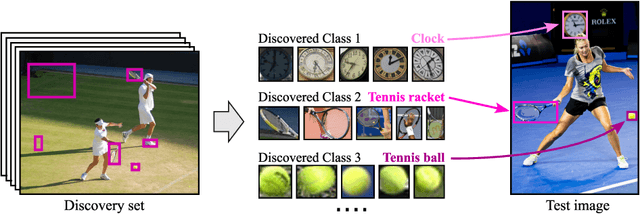
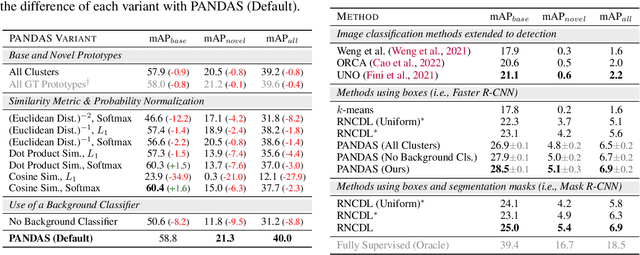


Abstract:Object detectors are typically trained once and for all on a fixed set of classes. However, this closed-world assumption is unrealistic in practice, as new classes will inevitably emerge after the detector is deployed in the wild. In this work, we look at ways to extend a detector trained for a set of base classes so it can i) spot the presence of novel classes, and ii) automatically enrich its repertoire to be able to detect those newly discovered classes together with the base ones. We propose PANDAS, a method for novel class discovery and detection. It discovers clusters representing novel classes from unlabeled data, and represents old and new classes with prototypes. During inference, a distance-based classifier uses these prototypes to assign a label to each detected object instance. The simplicity of our method makes it widely applicable. We experimentally demonstrate the effectiveness of PANDAS on the VOC 2012 and COCO-to-LVIS benchmarks. It performs favorably against the state of the art for this task while being computationally more affordable.
On Good Practices for Task-Specific Distillation of Large Pretrained Models
Feb 17, 2024



Abstract:Large pretrained visual models exhibit remarkable generalization across diverse recognition tasks. Yet, real-world applications often demand compact models tailored to specific problems. Variants of knowledge distillation have been devised for such a purpose, enabling task-specific compact models (the students) to learn from a generic large pretrained one (the teacher). In this paper, we show that the excellent robustness and versatility of recent pretrained models challenge common practices established in the literature, calling for a new set of optimal guidelines for task-specific distillation. To address the lack of samples in downstream tasks, we also show that a variant of Mixup based on stable diffusion complements standard data augmentation. This strategy eliminates the need for engineered text prompts and improves distillation of generic models into streamlined specialized networks.
Weatherproofing Retrieval for Localization with Generative AI and Geometric Consistency
Feb 14, 2024



Abstract:State-of-the-art visual localization approaches generally rely on a first image retrieval step whose role is crucial. Yet, retrieval often struggles when facing varying conditions, due to e.g. weather or time of day, with dramatic consequences on the visual localization accuracy. In this paper, we improve this retrieval step and tailor it to the final localization task. Among the several changes we advocate for, we propose to synthesize variants of the training set images, obtained from generative text-to-image models, in order to automatically expand the training set towards a number of nameable variations that particularly hurt visual localization. After expanding the training set, we propose a training approach that leverages the specificities and the underlying geometry of this mix of real and synthetic images. We experimentally show that those changes translate into large improvements for the most challenging visual localization datasets. Project page: https://europe.naverlabs.com/ret4loc
SLACK: Stable Learning of Augmentations with Cold-start and KL regularization
Jun 16, 2023



Abstract:Data augmentation is known to improve the generalization capabilities of neural networks, provided that the set of transformations is chosen with care, a selection often performed manually. Automatic data augmentation aims at automating this process. However, most recent approaches still rely on some prior information; they start from a small pool of manually-selected default transformations that are either used to pretrain the network or forced to be part of the policy learned by the automatic data augmentation algorithm. In this paper, we propose to directly learn the augmentation policy without leveraging such prior knowledge. The resulting bilevel optimization problem becomes more challenging due to the larger search space and the inherent instability of bilevel optimization algorithms. To mitigate these issues (i) we follow a successive cold-start strategy with a Kullback-Leibler regularization, and (ii) we parameterize magnitudes as continuous distributions. Our approach leads to competitive results on standard benchmarks despite a more challenging setting, and generalizes beyond natural images.
 Add to Chrome
Add to Chrome Add to Firefox
Add to Firefox Add to Edge
Add to Edge